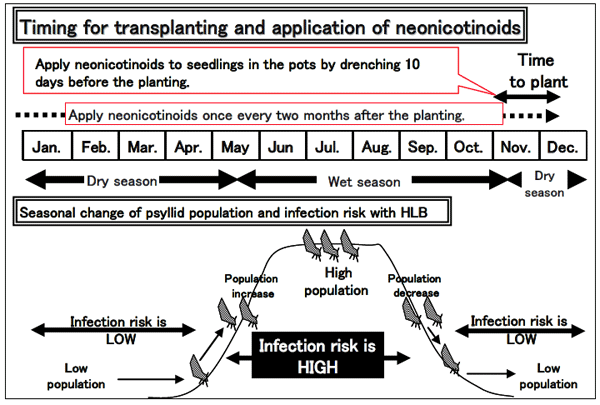Management for the reduction of young king mandarin trees infected by citrus greening disease in the Mekong Delta Region
Description
Citrus greening disease is caused by the pathogen, Candidatus Liberibacter asiaticus, which is transmitted by the citrus psyllid, Diaphorina citri. Citrus trees in the Mekong Delta can grow throughout the year, giving opportunities for the pathogen to infect trees all year around. Citrus trees infected by the pathogen during the early or young stage (< 2 yr) are likely to yield little or no crop due to the disease, while trees infected in later stages would produce more or less some fruits. Hence, it is perceived that the management for the reduction of infection during the young stage is important for the stable culture of citrus. In Vietnam, it is recommended to apply systemic insecticides around tree roots (previously on the main trunk) once every two months. However, few or no studies have been carried out to address the efficiency of scheduling the planting season in accordance with the seasonal prevalence of the vector or the detectable changes in tree infection level after planting. Here, we supply a new management of citrus greening to optimize the planting season with the reduction in the infection risk of young citrus trees.
Psyllids increase their densities once a year, leading the infection of trees to be delayed by three to five months (Fig. 1). Taking the latent period of the disease into account, the infection risk is higher in the late dry season to early wet season and lower in other seasons. Neonicotinoids efficiently control psyllids 10 days after application, of which efficacy is maintained for two months (Fig. 2). These chemicals are proven sufficiently efficient to control the vector on young citrus trees planted in the early wet season when the infection risk is high. The planting of seedlings in November when the infection risk is low evidently reduces the occurrence of the disease even in non-chemically controlled blocks, and few trees were infected for the first year (Fig. 3). Combining the above observations, the following management can be recommended (Fig. 4): (1) Seedlings should be planted in the season when the infection risk is low; (2) Neonicotinoids should be applied 10 days before planting; (3) Either of these chemicals should be used once every two months thereafter.
The above management should be extended to organisations or persons involved in citriculture in the Mekong Delta Region of Vietnam. In other countries, possible differences in psyllid ecology and the regulation of chemical uses may confine the application of this management.
Figure, table
-
Fig. 1.
Seasonal changes of citrus psyllids density and the disease progress of citrus greening in newly planted citrus groves (cv. ‘king mandarin’) in the Mekong Delta, Vietnam -
Fig. 2.
Mortality of psyllids on seedlings of king mandarin applied with neonicotinoids
Error bars show standard errors of the mean.
Broken and solid lines show the culturing periods in a nursery and in an orchard, respectively.
* Corrected with the Abbott's formula -
Fig. 3.
Effects of the planting season and the timing of application of neonicotinoids on the incidence of Huanglongbing (HLB) in king mandarin orchards A: Planted in May, 2007 (late in dry season: high psyllid population). B: Planted in November, 2007 (late in wet season: low psyllid population). Conventional application: Neonicotinoids were applied on soil around trees once every two months after the planting. Advanced application:Neonicotinoids were applied 10 days before planting and as above thereafter. -
Fig. 4.
Schematic diagram of the management of Huanglongbing for king mandarin trees in the early stage of growth in southern Vietnam.
- Affiliation
-
Japan International Research Center for Agricultural Sciences Tropical Agriculture Research Front
- Term of research
-
FY2008(FY2006~2011)
- Responsible researcher
-
ICHINOSE Katsuya ( Tropical Agriculture Research Front )
TUAN Do Hong ( Southern Fruit Research Institute )
- ほか
- Japanese PDF
-
2008_seikajouhou_A4_ja_Part25.pdf471.81 KB




